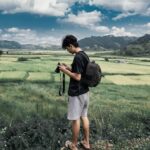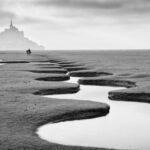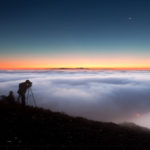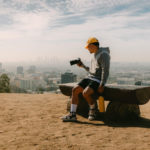If you just got your first DSLR or if you’ve had one for awhile and want to get serious about taking better pictures, the advice in this article is for you.
Delete Bad Photos
If you don’t do this already, then start. The pursuit of any interest will include disappointment, so be prepared to delete them from your hard drive—that is, after you’ve taken a hard look at WHY they don’t look good. But, the more good literature and tutorials you absorb, as well as advice from the more experienced, your pics will begin to take on more vibrancy and life.

“Photographer” captured by Leon Lee (Click image to see more from Lee.)
Take Tons of Pictures
After shooting reams of pictures, you start to realize that it’s a matter of visualizing the final result, and more importantly, controlling the technical aspects of your camera and the lighting that surrounds your subject. As your technique becomes more instinctive, results then become more predictable as time moves on. Let’s break this down a bit more.
Learn How to Use Your Camera’s Advanced Features
So you have a nice camera. Big deal. So do a lot of other people, and yet their pictures do nothing more than document where they’ve been. To move beyond that, you need to master your camera by overcoming the fear of using all the buttons and dials. I recommend that you spend some dedicated time experimenting. (If you’re using film, a few rolls sacrificed purely for the sake of learning will have huge payback later. I do this when I buy a new flash or camera body, as all the TTL metering and calculator dials in the world don’t guarantee a good shot. Sorry, I let out some geek-speak there!)
Start with setting your camera to ISO 100 and then 800. Use a tripod for the 100 ISO. The other settings can do without one if the light is bright enough. Lower ISO settings are good for waterfalls, still life, portraits—anything that takes bit of setup time. An ISO of 100 will still do for handheld shots in bright sun, even if there are a few clouds. And ISO 800 is for action-stopping situations like sports. The point is, the lower the number, the slower the shutter speed.

“Ben Davis Girl Golf Sectional Tournament 10” captured by Oscar Salinas (Click image to see more from Salinas.)
Understand ISO
You may know this already, but the higher the ISO, the more sensitive your sensor. Modern DSLR cameras are smart. Taking pictures with the various settings I recommend above will make your camera vary its shutter speed and/or aperture size to let in just the right amount of light. The basic results from each picture will be similar. The main difference between these different ISOs is speed. (A “fast” ISO needs a fast shutter speed to match its light requirements.) However, be aware that digital cameras exhibit what is called “digital noise” at their higher ISO ratings, which appear as artifacts in the photo.
Master the 4 Important Elements of Photography
Now, there are four very important elements that you have control over here. This is at the crux of all photography, and if you stop depending on your camera’s program mode and take control of these variables as you understand them more, you then have enormous creative freedom. They are: shutter speed, aperture size, exposure, and framing. The first three are technical, and the fourth is more artistic in nature.
Before starting, please familiarize yourself with a couple things on your camera. Learn to change the mode from program to shutter priority, aperture priority, and lastly, how to read the internal light meter. It’ll all be in your manual.
1. Shutter Speed
As mentioned earlier, in program mode, your camera varies the shutter and aperture settings based on a number of elements, but mostly on the ISO setting. So if aperture is kept constant, and ISO is changed, the shutter will need to speed up or slow down to expose correctly. When shutter speed needs to be fast to stop motion in lower light, a fast ISO is required, such as 800 or 1600 ISO.
But if shutter speed is not your first consideration (i.e., when the camera is steady on a tripod, such as in portraiture), go for a slow speed that will render a better quality shot.
Your camera will have some means of moving from program mode to shutter-priority (or “TV” on most cameras). Again, read your camera’s manual to understand how to move into this mode. Once there, keep the shutter at, say, 1/250 of a second. Your camera will then automatically adjust the aperture to let in just the right amount of light for a proper exposure. Fire off a few shots in this mode, changing the subject and light intensity with each exposure. An example of a nice long-exposure picture is that of waterfalls. With your camera on a tripod, set the shutter to ½ second if your ISO is slow enough, and expose based on the method described in the “Exposure” section below.

“Slow Motion on the Rocks” captured by Mitch Johanson (Click image to see more from Johanson.)
2. Aperture
Ever walk into a dark room right after being outdoors in the bright sunlight? Notice how dark it is, as if you have sunglasses on? We know it’s our eyes adjusting, because if we stand there a couple minutes, the room lightens up. That’s thanks to the amazing engineering behind the iris in each of your eyes, which controls the amount of light that hits our retinas. Your camera’s aperture setting is to your camera what your iris is to your eye.
Now’s the time to put that dial into Aperture priority mode, or “Av.” Here’s where you choose to set the aperture (or “f-stop”); the camera then chooses an appropriate shutter speed.
The real fun starts when you manually control the aperture size in your camera lens, because something called “depth of field” comes into play here. I’m sure you’ve seen pictures in which the subject is in focus but everything in the background is not. This draws attention to your subject, whether it is a bird, insect, flower—you’re not distracted by surrounding elements in the frame. The amount that the background and foreground are out of focus is up to you, and this is controlled by opening and closing the aperture with the f-stop control. Your camera’s manual will provide details on manually changing the f-stop setting.

“Blending In” captured by Steve O. (Click image to see more from Steve.)
When shooting various test shots, your camera will alter the shutter speed quite a bit as you experiment with different f-stop ratings. Keep in mind that the smaller the number, the larger the opening, and the more light that hits the sensor. An f-stop of 2.8 will yield a fairly shallow depth-of-field, whereas f/22 is almost like a pinhole camera, where everything is in focus—this is good for landscape shots, but probably will require a tripod because of the slower shutter. An f-stop of 5.6 or 8 will yield an average-looking photo and will be very sharp. This is because most lenses perform best in this range.
3. Exposure
Most (if not all) DSLRs have an exposure lock button. This is to set the camera’s exposure at an optimal level in case your subject is off-center, and/or the optimal “mid-gray” portion of the frame is off-center. This is because cameras are programmed to use the center of your picture as a reference point when measuring light. Your camera has a microchip that measures the amount of light when you snap a shot at the current setting, so in program mode, it will set the aperture and shutter speed based on a number of variables too complex for this article, but suffice to say it tries to make an intelligent choice. And most times it will, but if you were only a point-and-shooter, you wouldn’t be reading this far, would you?
So if the optimal light intensity (again, mid-gray) is somewhere off-center of the picture, what do we do? Point the camera to this mid-gray portion of your shot, lock the exposure, re-frame, then shoot! This is a great way to avoid many common exposure mistakes. Common reference points are a person’s face if the shot includes people, or green grass in an outdoor shot. Many winter pictures display snow as grey instead of white for this reason; your camera is only trying to “average” the exposure.

“Peaceful” captured by Sarah Ball (Click image to see more from Ball.)
Why mid-gray (or skin tone)? This is used as a reference for all camera and light meter exposure systems. It exposes flesh at just the right amount, so it’s a good idea to get a reading on a section of your picture that is closest to this mid-toned shade. If you want to get technical, purchase an 18% gray card and use that as a reference. Your pictures will be dead-on. Remember to get an exposure lock when the card is directly facing the camera lens.
So, knock off a bunch more shots, playing with aperture size and changing ISO settings. By keeping an eye on your camera’s light meter, you’ll soon discover both the variations and limitations of your camera.
4. Framing
Mentioned above, “framing” your shot is adjusting the distance and angle between the camera and the subject so as to create a pleasing photograph. A rule of thumb in many situations (where the object you’re photographing doesn’t take up the entire shot) is something called the “Rule of Thirds.”
Imagine dividing the frame into thirds, both horizontal and vertically. Now line up your subject in any one of the intersecting points of the lines used to divide up the picture. These “hot spots” are deemed most aesthetically pleasing, as opposed to always having your subject in the center. This isn’t always the case, but something to keep in mind.
Another nice touch is to allow elements of the picture to become a frame themselves, like an overhanging tree bough. Other times these things clutter and distract, but experience is the best teacher here. Simplicity and elegance go a long way in creating pictures with “wow” factor.
Happy Shooting
So, with your camera, some time, and a notepad and pencil, one afternoon’s experimentation will go a long way in de-mystifying the ins and outs of serious photography. Whether this is at a hobby or professional level, the four elements of shutter speed, aperture, exposure, and framing are the essential ingredients in creating art that will please yourself and others for years to come.
About the Author:
James Hutchison is a graduate of the New York Institute of Photography, and a member of the National Association of Photoshop Professionals.
Like This Article?
Don't Miss The Next One!
Join over 100,000 photographers of all experience levels who receive our free photography tips and articles to stay current:







DELETE BAD PHOTOS “If you have not done this before, then start”